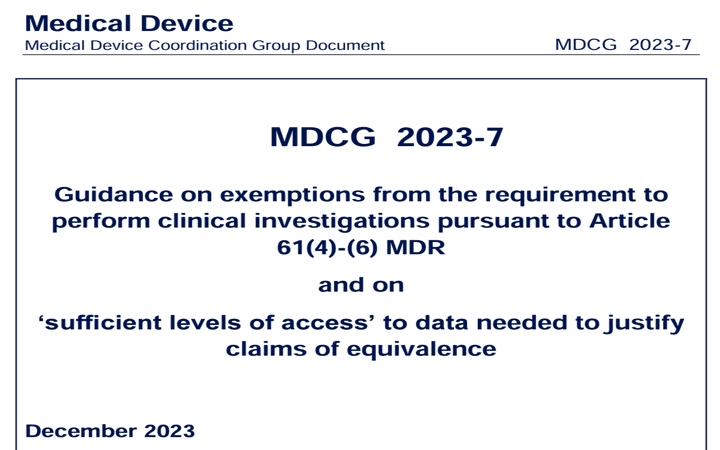
The European Union Medical Device Regulation (EU MDR) has brought significant changes to the medical device industry. One area that has raised questions and uncertainties is the application of Articles 61(4)-(6) of the EU MDR on the requirement of clinical investigations and equivalence. However, there is good news! The Medical Device Coordination Group (MDCG) has recently published a guidance document, MDCG 2023-7, which provides much-needed clarification on the practical application of these articles. In this blog post, we will explore the key points of MDCG 2023-7 and its implications for manufacturers.
Key Takeaways
- MDCG 2023-7 provides clarity on exemptions from clinical investigations for implantable and class III devices under Article 61(4).
- For legacy devices under Article 61(6)(a) and listed Well-Established Technologies (WET) devices in 61(6)(b), manufacturers can use data from another equivalent device without the need for a contract.
- Emphasizes the importance of “sufficient levels of access” to robust clinical data to support claims of equivalence.
Exemptions: One of the main clarifications provided by MDCG 2023-7 is regarding the exemptions from the requirement to perform clinical investigations for implantable and class III devices, as stated in Article 61(4) of the EU MDR. The guidance outlines the conditions under which these devices can be exempted from pre-market clinical investigations. This clarification is significant as it reduces barriers to market entry for many implantable and class III devices. The following cases are under consideration for exemptions:
- Previously Certified Devices under Directives: Devices that have already been certified under previous directives and have several years of market experience may be exempt.
- Availability of Post-Market Clinical Follow-Up Data: Devices with available data from post-market clinical follow-up (PMCF), which show no safety or performance issues, may be considered for exemption.
- Recent Design Examination or Renewal: Devices that have undergone a design examination or renewal within the last five years, with adherence to stringent requirements for clinical data and post-market surveillance, may qualify for exemption.
- Compliance with Stringent Guidelines: Devices that comply with rigorous guidelines like MedDev 2.7/1 rev 4, ensuring a conformity assessment similar in rigor to current MDR requirements, may be exempt.
- Devices with Equivalent Safety and Performance: If a device is a modification of an existing device by the same manufacturer and can demonstrate equivalent safety and performance, it may be exempt.
- Devices with Full Contractual Access to Data: Devices that rely on equivalence and have a contract with the original manufacturer, providing full access to technical documentation, may be exempt.
- Low-Risk Devices as per Article 61(6)(b): Devices listed in Article 61(6)(b) of the MDR, typically considered low-risk and standard of care with a well-known safety and performance profile, may be exempt.
Equivalence plays a crucial role in this guidance. MDCG 2023-7 emphasizes that Articles 61(4)-(6) do not define when equivalence may or may not be used. Instead, they define when implantable and class III devices can be exempted from pre-market clinical investigations. This distinction is important to understand.
Immediate Impacts: For legacy devices described in Article 61(6)(a) of the EU MDR, and the listed Well-Established Technologies (WET) devices in Article 61(6)(b), manufacturers can include data from another manufacturer’s demonstrated equivalent device in their own device’s clinical evaluation. Importantly, this can be done without the need for a contract under certain circumstances as outlined below.
- Legacy Devices with Extensive Market History: If your device has been previously certified under older Directives and has a significant market history, along with data from Post-Market Clinical Follow-Up (PMCF), indicating no safety or performance issues.
- Design Variants of Manufacturer’s Own Devices: If the device in question is a design modification of one of the manufacturer’s own devices, and the manufacturer can demonstrate equivalence (as per Article 61(4) of the MDR) with their own existing device data.
- Low-Risk Devices with Well-Known Profiles: For devices listed under Article 61(6)(b) of the MDR, which are considered low risk and have a well-known safety and performance profile, typically standard of care devices.
It is important to note, however, that “sufficient levels of access” to the equivalent device’s data need to be demonstrated.
Conclusion: The publication of MDCG 2023-7 brings much-needed clarity to the practical application of EU MDR Articles 61(4)-(6). It opens up strategies and pathways that were previously thought to be blocked off, reducing barriers to market entry for implantable and class III devices. Manufacturers should review their clinical development plans to determine if this new understanding could affect their clinical investigation strategy or accelerate product launch timelines.
By embracing the guidance provided in MDCG 2023-7, manufacturers can position themselves at the forefront of compliance, ready to navigate the evolving landscape of medical device regulations with confidence and clarity.
Please note that this blog post is based on the information provided in MDCG 2023-7. For more detailed and specific guidance, it is recommended to refer to the official document.
